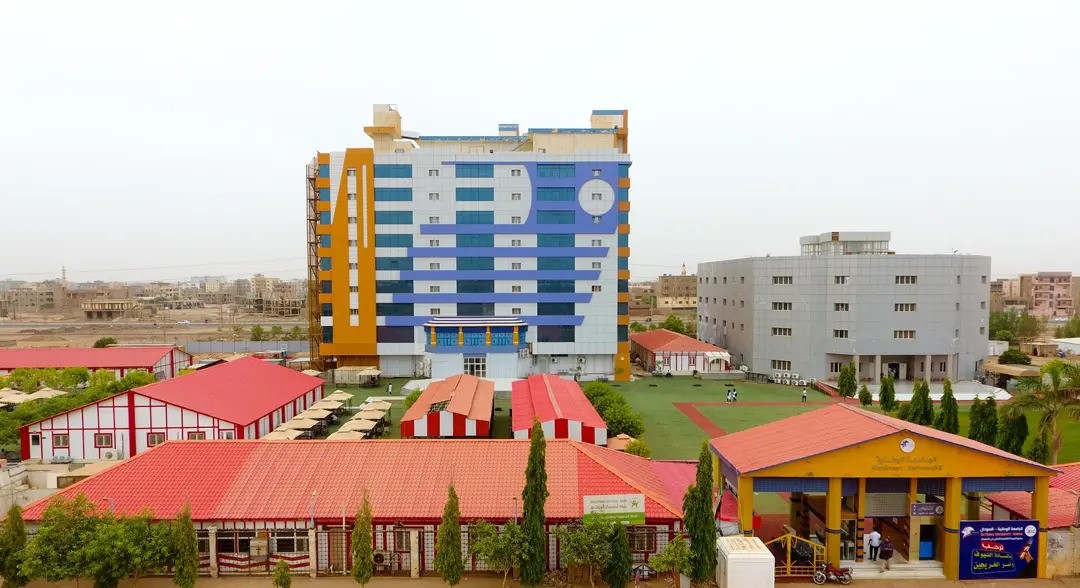Communities in DSpace
Select a community to browse its collections.
Recent Submissions
Anti-bacterial potential of (Acacia nilotica, Trigonella foenum graecum, Punica granatum and Commiphora myrrha) crude extracts against diverse drug sensitive and resistant bacterial species
(Plant Science Today, 2022) Osman, Meaad Fakhraldeen Abdalla; Abdalla, Sababil Salih; Abdelghani, Sara; Mangi, Altaf Ali; Eltayeb, Lienda Bashier
The alarming increase in bacterial resistance to antibiotics caused some
authors to state that we are approaching a post-antibiotic era and medical
catastrophe, the study aimed to assess the antimicrobial effects of selected
plant extracts against several sensitive and resistant bacterial isolates. Ex
perimental cross-sectional study was conducted, 70% ethanol crude Acac
cia nilotica, Trigonella foenum-graecum, Punica granatum and Commiphora
myrrha extract was prepared and several commercial antimicrobials agent
tested, the antibacterial activity was investigated using the disc diffusion
method. The inhibition zones' diameters (mm) were calculated and inter
preted by Zone Diameter Interpretative Standards. Data were analyzed by
using (SPSS) software version 22. About 200% of A. nilotica and T. foenum
graecum showed bactericidal effects against Enterococcus faecalis, means
±SD (12.3 ± 2.8 and 12.5 ± 2.1). The activity of 200% C. myrrha extract was
highest against all diverse bacterial. Despite a relatively high inhibition zone
among all plant ethanol extracts, the findings demonstrate that there is no
statistical significance in the inhibitory activity impact of varying concentra
tions of 70% ethanol extracts of all plants extract against bacterial isolates
(P. value ≥ 0.05). The outcomes of the ethanol extracts of the used plant un
der study demonstrated that the herbal extract can be a superior antimicro
bial potential than the result of the commercial broad spectrum antimicro
bial agent utilized. C. myrrha extract was potent antimicrobial activity
against all diverse bacterial species.
Effect of Creative Teaching Intervention for Adolescents with Severe Refractory Asthma on their Own Medications Adherence, Asthma Control and Hospital Readmission
(International Egyptian Journal of Nursing Sciences and Research (IEJNSR), 2024) Hassan, Ghada.A.; Mohammed, Esraa Gamal; Mohamed, Rawia Abd El-ghany
Background: Severe refractory asthma characterized by difficulty in achieving disease control
despite high-intensity treatment. Asthma burden is particularly notable in adolescents and associated
with higher rates of prevalence and mortality compared with younger children. So, healthcare
professionals should dedicate their effort to educate adolescents with severe refractory asthma. Aim:
evaluate the effect of creative teaching intervention for adolescents with severe refractory asthma on
their own medications' adherence, asthma control, and hospital readmission. Research design: A quasi-
experimental design. Setting: The pediatric in-patient wards at Benha University Hospital. Sample: It is
composed of 100 adolescents with severe refractory asthma who attended in the previous setting during
study period. Tools of data collection: Tool I; Structured Interview Questionnaire, Tool II; observation
checklist, Tool III: Asthma Morisky Medication Adherence Scale, Tool IV; Asthma Control Test. Tool
V; Assessment sheet for asthma outcomes. Results: Less than two thirds of the adolescents in study
group had high medication adherence level, and approximately two thirds of them had well asthma
control, in addition to, two thirds did not readmit to the hospital after 30 post intervention with
statistically significant differences between study and control group after the intervention. Conclusion:
creative teaching intervention impacted positively on adolescent's knowledge level, practice,
medications adherence, asthma control and decrease hospital readmission. Recommendation: Further
studies for implementation of other creative teaching interventions for enhancement of asthma care
should be done.
PI3K/AKT/mTOR Pathway in Breast Cancer Pathogenesis and Therapy: Insights into Phytochemical-Based Therapeutics
(Nutrition and Cancer, 2025) Wali, Adil Farooq; Talath, Siajunisa; El Tanani, Mohamed; Rangraze, Imran Rashid; Babiker, Rasha; Shafi, Sadat; Bansal, Ruby
Breast cancer (BC) is listed as the most prevalent cancer form in women worldwide, with major
subtypes classified by hormone receptor (HR) and HER2 status including, HR+/HER2– (~65–70%),
HER2+ (~15–20%), Triple-Negative-HR–/HER2– (~10–15%) and rare sybtypes (<5%). Scientific
evidence has revealed that PI3K/AKT/mTOR signaling cascade plays an important role in the
development and progression of BC, contributing to key cellular processes including cell growth,
proliferation, angiogenesis, and metastasis. Dysregulation of the components of this cascade
including functional loss of Phosphatase and TENsin homolog (PTEN), PI3K hyperactivation, and
gain-of-function of AKT, are frequently observed in BC subtypes, making it a promising target for
therapeutic intervention. A myriad of studies have documented the potential of phytochemicals,
including curcumin, chrysin, fisetin, genistein, resveratrol and lycopene as modulators of the
PI3K/AKT/mTOR axis. These phytochemicals exhibit multifaceted mechanisms of action, including
inhibition of key kinases, induction of apoptosis, suppression of angiogenesis, and reversal of
resistance to chemotherapy. This review aims to provide a detailed overview about the role of
PI3K/AKT/mTOR alteration in BC development and the current research on phytochemicals that
modulate the PI3K/AKT/mTOR pathway in BC. We documented the molecular mechanisms
through which these compounds exert their effects, their potential synergistic interactions with
conventional therapies, and the challenges and prospects for their clinical application. The
evidence presented underscores the promise of phytochemicals as novel, less toxic adjuncts to
traditional BC therapies, warranting further exploration and development for clinical use
Effect of Gum Arabic (Acacia Senegal) supplementation on visceral adiposity index (VAI) and blood pressure in patients with type 2 diabetes mellitus as indicators of cardiovascular disease (CVD): a randomized and placebo-controlled clinical trial
(Lipids in Health and Disease, 2018) Babiker, Rasha; Elmusharaf, Khalifa; Keogh, Michael B.; Saeed, Amal M.
Background: There is a strong association between cardiometabolic risk and adipose tissue dysfunction with great
consequences on type 2 diabetic patients. Visceral Adiposity Index (VAI) is an indirect clinical marker of adipose
tissue dysfunction. Gum Arabic (GA) is a safe dietary fiber, an exudate of Acacia Senegal. Gum Arabic had shown lipid
lowering effect in both humans and animals. The aim of this trial was to determine the effect of GA supplementation
on anthropometric obesity marker, Visceral Adiposity Index (VAI) and blood pressure in patients with type 2 diabetes
mellitus.
Methods: This randomized, double blinded, placebo controlled trial recruited a total of 91 type 2 diabetic patients (73
females, 18 males), age (mean ±SD) 50.09±9.3 years on hypoglycemic agents and were randomly assigned into two
groups, either to consume 30 g of GA or 5 g of placebo daily for 3 months. Anthropometric obesity markers were
measured and indices were calculated. Blood pressure was measured and high density lipoprotein (HDL) and triglycerides
(TG) were determined in fasting blood samples at the start and end of the study period.
Results: After intervention, Gum Arabic decreased BMI and VAI significantly (P < 0.05) in GA group by 2 and 23.7%
respectively. Body adiposity index significantly decreased by 3.9% in GA group while there were no significant
changes in waist circumference or waist-to-hip ratio (WHR). Systolic blood pressure significantly decreased by 7.6% in
GA group and by 2.7% in placebo group from baseline with no significant changes in diastolic blood pressure in the
two groups.
Conclusion: Gum Arabic consumption at a dose of 30 g/d for 3 months may play an effective role in preventing
weight gain and modulating adipose tissue dysfunction in type 2 diabetic patients, although no effect has been
shown in waist-to-hip ratio
Green synthesis of silver nanoparticles using Sudanese Candida parapsilosis: a sustainable approach to combat antimicrobial resistance
(BMC Microbiology, 2025) Ibrahim, Nesreen A. A.; Saeed, Humodi A.; Saeed, Samar M.; Mohamed, Osama; Suliman, Omnia H.; Ibrahim, Sabah A. E.; Mohamed, Sofia B
Background Antimicrobial resistance (AMR) is a critical global health challenge, particularly in Sudan, where
the overuse and misuse of antibiotics have driven the rise of multidrug-resistant (MDR) pathogens. Conventional
antimicrobial strategies often fall short due to rapid resistance development and limited efficacy, highlighting
the need for novel approaches. Nanotechnology offers promising alternatives, with silver nanoparticles (AgNPs)
demonstrating potent broad-spectrum antimicrobial activity. This study aims to develop an eco-friendly synthesis of
AgNPs using Candida parapsilosis (C. parapsilosis), an untapped yeast strain isolated from Sudanese soil, to combat
AMR.
Results Biosynthesis of AgNPs using C. parapsilosis was successfully confirmed through UV-Vis spectroscopy,
X-ray diffraction (XRD), and high-resolution transmission electron microscopy (HRTEM), revealing well-defined
nanoparticles. The biosynthesized AgNPs exhibited strong antibacterial activity against both ATCC reference
strains and MDR clinical isolates of Gram-positive and Gram-negative bacteria, with inhibition zones increasing in
a concentration-dependent manner. At optimal concentrations, inhibition zones reached 29 mm for Pseudomonas
aeruginosa (P.aeruginosa) (ATCC 27853), while clinical isolates of Salmonella typhi (S. typhi) (24.5 ± 0.58 mm) and
Escherichia coli (E. coli) (23.8 ± 0.79 mm) exhibited significant susceptibility. Minimum inhibitory concentration (MIC)
and minimum bactericidal concentration (MBC) assays demonstrated potent bactericidal activity, particularly against
E. coli and Klebsiella pneumoniae (K. pneumoniae) at 0.3125 mg/mL. Furthermore, AgNPs synergistically enhanced
the efficacy of conventional antibiotics in a species- and antibiotic-dependent manner. The strongest synergy was
observed in Enterococcus faecalis (E. faecalis) (up to 9.84-fold with Colistin) and Acinetobacter baumannii (A. baumannii)
(up to 5.11-fold with Ceftazidime), suggesting that AgNP-enhanced antibiotic efficacy varies depending on bacterial
species, nanoparticle synthesis method, and antibiotic type.
Conclusions This study presents a novel and sustainable approach to tackling AMR by leveraging Sudanese yeast
strains for the green synthesis of AgNPs. The findings underscore the potential of AgNPs as an effective antibacterial
agent, both independently and in combination with conventional antibiotics, to combat MDR pathogens. By
integrating microbiology and nanotechnology, this research offers a cost-effective and environmentally friendly

